Call for your appointment today 914-666-4665 | Mt. Kisco, New York

The Chronic Lyme Disease Controversy
I’ve been treating chronic Lyme disease for 37 years. In that time, I’ve witnessed firsthand the struggles of patients whose symptoms didn’t resolve after the standard course of antibiotics. I’ve also seen how the medical community has been deeply divided on the existence of chronic Lyme disease.
Many of my colleagues—some of whom I deeply respect—have argued with me over the years, insisting that chronic Lyme disease doesn’t exist. They believed that once a patient completes a prescribed course of antibiotics, any lingering symptoms must be the result of something else—an autoimmune response, lingering inflammation, or simply the wear and tear of everyday life. Some even suggested that the symptoms were psychological, a product of health anxiety rather than a persistent infection.
Their skepticism wasn’t entirely unfounded. The medical community places a high value on evidence-based medicine, and in the absence of a universally accepted diagnostic test for chronic Lyme disease, many physicians were unwilling to acknowledge what they couldn’t definitively prove. But for me, the proof wasn’t in a single test—it was in the patients I saw every day, the ones who continued to struggle with unrelenting fatigue, joint pain, cognitive dysfunction, neuropathy, and dysautonomia (POTS) long after their treatment ended.
A Shift in Perspective: Acknowledging Chronic Manifestations
While some colleagues remained rigid in their views, others began to recognize that Lyme disease could lead to serious, chronic complications. Over time, Lyme arthritis, Lyme encephalopathy, Lyme neuropathy, Chronic Neurologic Lyme, Neuropsychiatric Lyme, PANS, POTS, and PTLDS were increasingly acknowledged in medical literature. These weren’t vague, unproven conditions—these were well-documented manifestations of Lyme disease that had been observed in patients.
It was particularly interesting to see that many of my colleagues—who had once completely dismissed the idea of chronic Lyme disease—began to accept the concept of Post Treatment Lyme Disease Syndrome (PTLDS). They acknowledged that some patients remained ill after treatment, sometimes for years. They saw the ongoing fatigue, cognitive dysfunction, and pain that persisted long after the initial infection.
But even as they accepted PTLDS, many still refused to consider that a persistent tick-borne infection might be responsible for these symptoms. They viewed PTLDS as an immunologic response to a past infection rather than a sign that the bacteria were still present. This created a paradox—if they could acknowledge that patients were still sick, why couldn’t they entertain the idea that there was an active infection driving these symptoms?
The Importance of Keeping an Open Mind
There’s still so much we need to learn about Lyme disease, particularly in its chronic form. Dismissing the possibility of persistent infection without fully exploring the science doesn’t serve patients. Many Lyme patients feel abandoned by the medical community because they are told their symptoms aren’t real or that they shouldn’t still be sick. But I’ve seen too many cases where patients responded positively to additional treatment—sometimes with extended antibiotics, sometimes with a combination of therapies targeting co-infections like Babesia or Bartonella.
I’ve also seen how new research continues to challenge old assumptions. Studies have shown that Borrelia burgdorferi, the bacteria that causes Lyme disease, can persist in animal models even after antibiotic treatment. Other research suggests that biofilms and persister cells may allow the bacteria to evade treatment, potentially leading to chronic symptoms. While the debate continues, the evidence pointing toward persistent infection is growing.
What This Means for Patients
For patients who continue to suffer, the name of their condition—whether it’s called chronic Lyme disease, persistent Lyme infection, or PTLDS—is far less important than the reality they live with every day. What matters most is that we, as doctors, listen to our patients, acknowledge their suffering, and remain open to the possibility that Lyme disease is far more complex than we once believed.
The more I work with Lyme disease patients, the clearer it becomes—chronic Lyme disease is real. And for many, the right treatment can mean the difference between lifelong suffering and reclaiming their health.
We must continue asking the tough questions, challenging old beliefs, and keeping an open mind. Because at the end of the day, it’s not about proving a point—it’s about helping people get their lives back.




Bravo Dr. Cameron!
Why not long Lyme which is similarly to long Covid…
Long Lyme has been proposed and used at times
My Lyme was under control until I had Covid. Since then, everything has flared up again, which has been discouraging.
I am sorry to hear that. I have patients who have had to retreat their Lyme disease
Dr. Cameron,
You were one of the very best Lyme doctors that I’ve seen. I have been dealing with this terrible disease for over 27 years! I can no longer make the drive from my home to NY. As I’m getting older it seems when I have a flare up it lasts longer and effects me harder. I might as well say I have no quality of life, everything hurts basically everyday, daily headaches and word retrieval are big issues, to top it all off at least 4 nights a week I get no sleep. Is there any doctors in the New Haven County you can recommend?
GlobalLymeAlliance and ILADS post doctors names if your primary needs any assistance. You are welcome to call my office with your question.